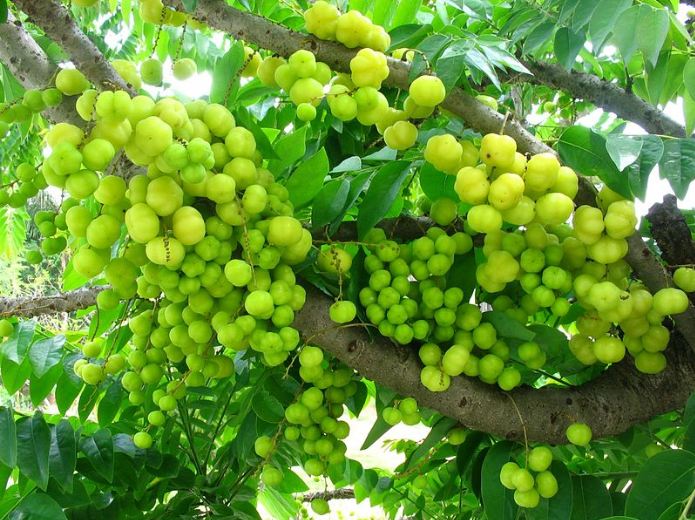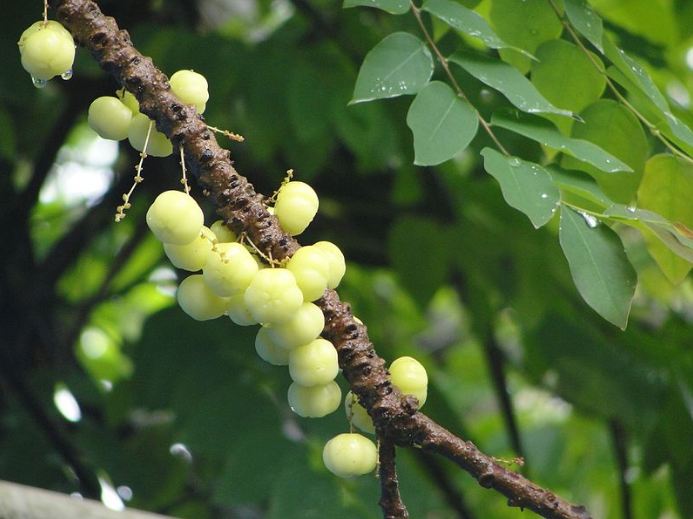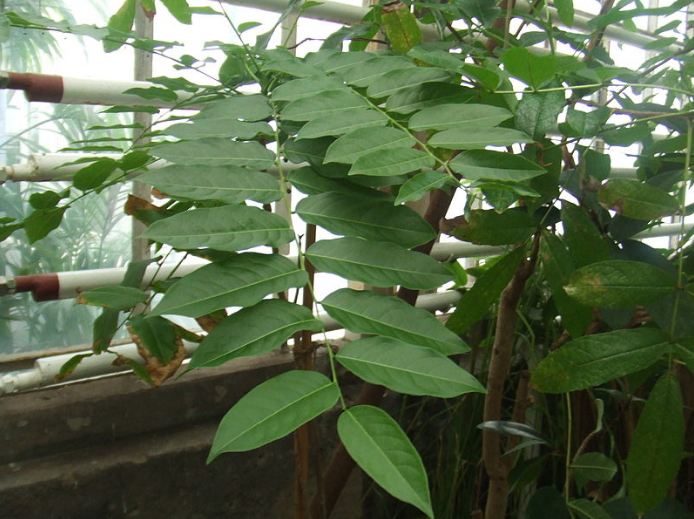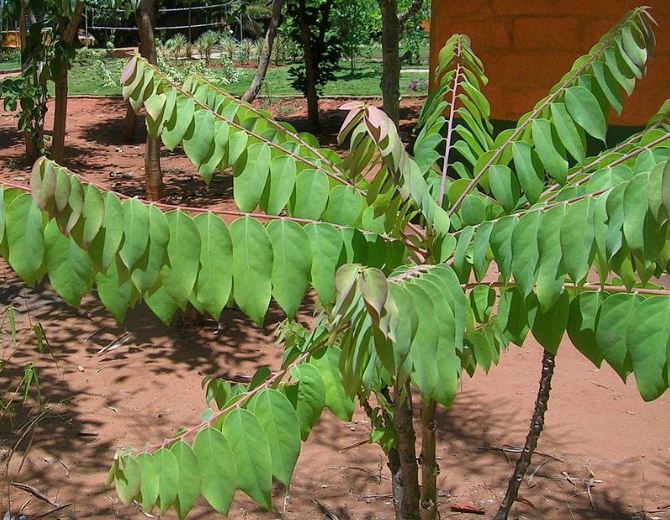The Cermai fruit is basically Otaheite gooseberry that is entirely different from the actual gooseberries. It is more acidic and is mostly a tropical fruit. Some other names for Cermai fruit are Malay, Tahitian, star, West India, and country gooseberry. It is scientifically known as Phyllanthusacidus. This gooseberry tree yields small yellowish-green berries belonging to the Phyllanthaceae family. Despite having the term gooseberry to identify this fruit, the Cermai fruit is in no way similar to gooseberries.
Cermai Fruit’s Description and Taste
These fruits are about 1 to 3 centimeters in diameter; hence, considered small. They appear to have a ribbed pattern on their skin that can be found in bunches all over the fruit. The skin of Cermai fruit is very smooth and firm. The fruit’s color varies from a lighter shade of green to a pale yellow or even white in some young fruits. The fruit’s flesh is very juicy and crisp – bearing a central stone that encloses about 4-6 seeds. When you taste this fruit, you can strongly sense a very sour taste along with a tad bit of tartness hitting you in the end.
Origin of the Cermai Fruit
It is believed that Cermai fruit originally belongs to Madagascar and was then brought into tropical regions of Southeast Asia by the people immigrating or coming for trade in ancient times. History narrates that the Cermai fruit arrived in Jamaica after being introduced to Southeast Asia’s tropical regions in 1793. It spread vastly throughout the tropical forests.
Currently, this fruit is usually spotted in the wild but can also be domestically planted. It can be found in Malaysia, Indonesia, Mauritius, Vietnam, Thailand, the Caribbean, Hawaii, Texas, and Florida, in addition to several tropical regions of South and Central America. This fruit can seldom be found in Colombia, Surinam, Peru, Brazil, and Venezuela.
Cermai Fruit Tree
Cermai fruit of Phyllanthusacidus is a fruit that grows on shrubs that go about 9 meters in height. Nature-wise, the Otaheite gooseberry spreads quickly in dense, bushy shrubs or small trees that have a characteristic thick crown and rough main branches. The branches have thick clusters of small branchlets at the tips that are mostly pink or green. The leaves of this tree are thin and can grow to about 2 to 7.5 cm in length. They are pointy and have a smooth green top with a tint of bluish-green on the underside.
Growing Gooseberry Trees
It is essential to have a greenhouse built on your farm for growing gooseberry trees if you do not live in a tropical or subtropical region. The tree is ideally domesticated in temperatures of southern Florida. The Otaheite gooseberry tree is known to survive in all types of soil, but it is preferred if you use a moist one. Mostly, the common method of growing these trees is by planting seeds.
However, it can also be propagated through budding, air layers, or greenwood cuttings. The tree starts to yield fruits after approximately four years of maturing. Once your Otaheite gooseberry tree is at the bearing age, you can have harvest it twice every year.
Uses of the Cermai Fruit
The Cermai fruit and its tree – the Otaheite Gooseberry tree – are used for several purposes. The tree leaves are cooked and consumed with savory dishes in various regions of Bangladesh, Indonesia, and India. The Cermai fruit is consumed fresh and raw in Indonesia. However, due to its intense tart taste, it is often added as a flavoring to other dishes rather than eaten raw. The fruit’s pulp and juice are extracted to make a liquid, which is then added to various chutneys, preserves, or relish.
It is also an important component of famous street food in the Philippines. The Cermai fruit is utilized in making vinegar or added to vinegar and salt solution to be sold along the roadside. One of the famous uses of Cermai fruit is candying them with sugar syrup. These candied Cermai fruits are stored in jars with syrup to be enjoyed as a snack. This tart fruit is also an important ingredient of a popular Thai dish called Som tam.
Commonly, the fruit is pitted and then blended with sugar to make a paste. It is then made into a thick sauce used as a dip. Sambal is also a widely popular sauce that has Cermai fruit paste mixed in it. Sambal is mostly eaten as a spread with cooked fish or noodles. Besides the leaves of this tree also being used as a leafy green in India, the bark of the Otaheite Gooseberry is also used for tanning hides.
You can experiment with Cermai fruit or its paste with several spices, such as cardamom, cumin, saffron, and ginger. Moreover, this fruit goes well with other fruits, including oranges, coconuts, pomelos, kiwis, kumquats, etc.
Health Benefits of Cermai Fruit
1. Might Help Relieve Constipation
Among the many nutrients and vitamins the Cermai fruit provides you is vitamin C. it is claimed that vitamin C helps relieve and treat constipation by having a cleansing effect in your intestine. A study conducted in Hong Kong on pre-school children outlined how lower levels of intake of vitamin C along with other nutrients were the cause of constipation. Hence, the consumption of fruits and vegetables rich in vitamin C, such as Cermai fruit, is said to relieve constipation.
2. Might Help Overcome Asthma
Though there is a wide gap in scientific research pursuing the benefits of Cermai fruit regarding asthma, some research gives hope that this might be beneficial. Seeds of the Cermai fruit are said to have benefits for recovering the breath in asthmatic people.
3. Healthy Skin
Owing to the benefits of vitamin C for the skin, the consumption of Cermai fruit is linked with healthier and clearer skin. This vitamin is widely used in manufacturing various skin products as it hydrates the skin by decreasing water loss and retaining moisture. Vitamin C also acts as an anti-inflammatory for the skin; thus, minimizing redness and resulting in an even skin tone.
Cermai Fruit – A Concise Review
Now that you know what Cermai fruit is, it is best to try and incorporate it into your diet if you can. It is loaded with vitamin C, which is the best thing you can consume for your skin. For the same reason, this fruit is considered beneficial for relieving constipation.
There is a lack of scientific pieces of evidence with regards to the health benefits of Cermai fruit, but it has been used in herbal and ancient medicine for a long time.





